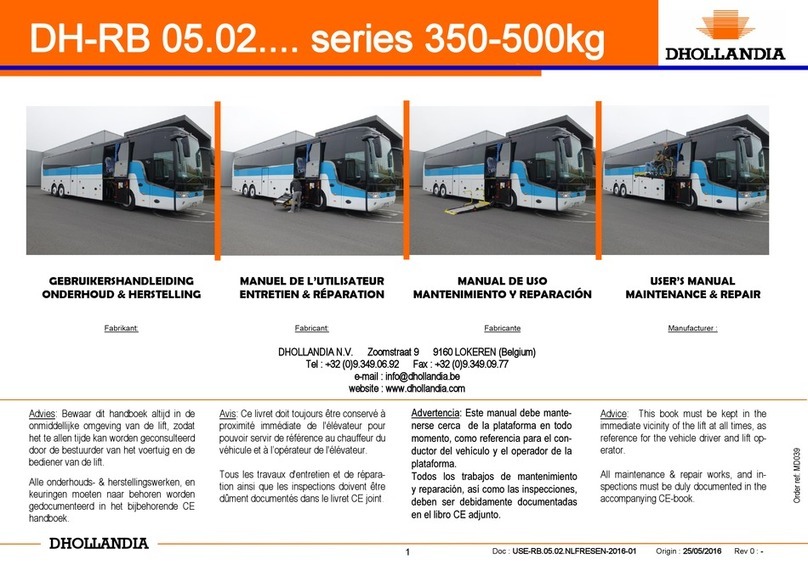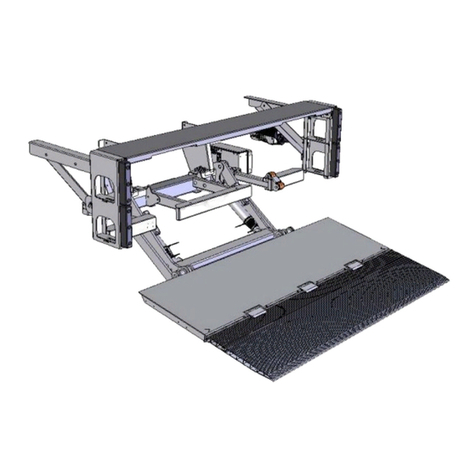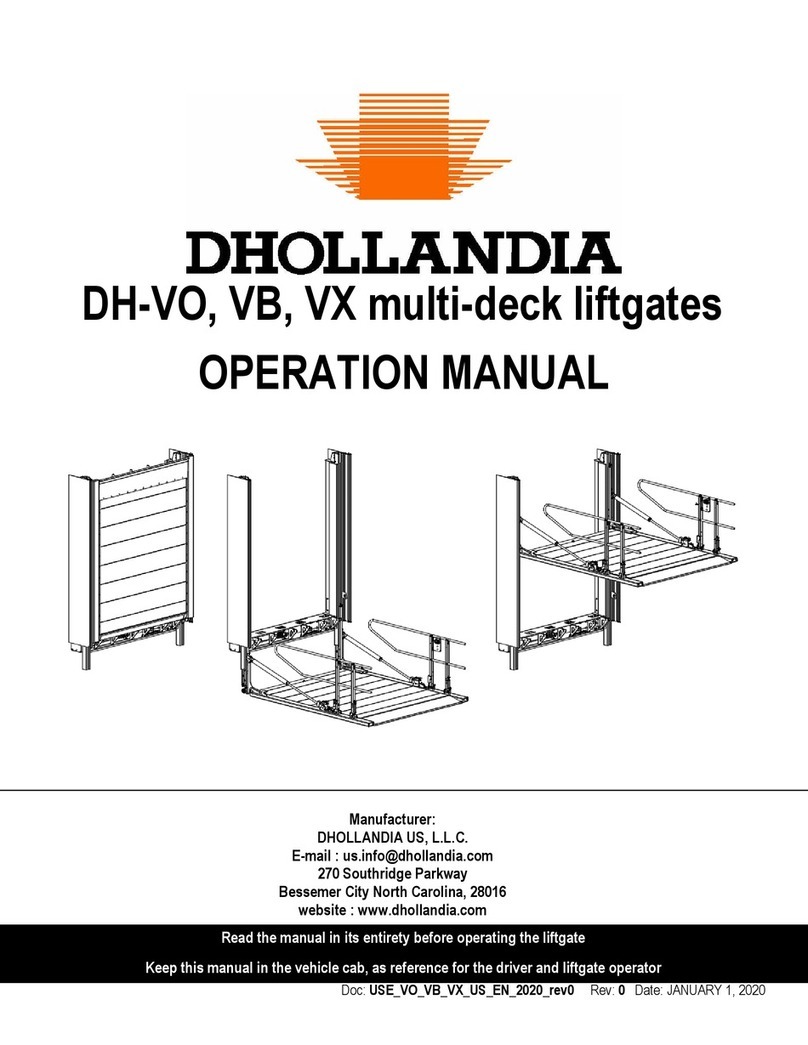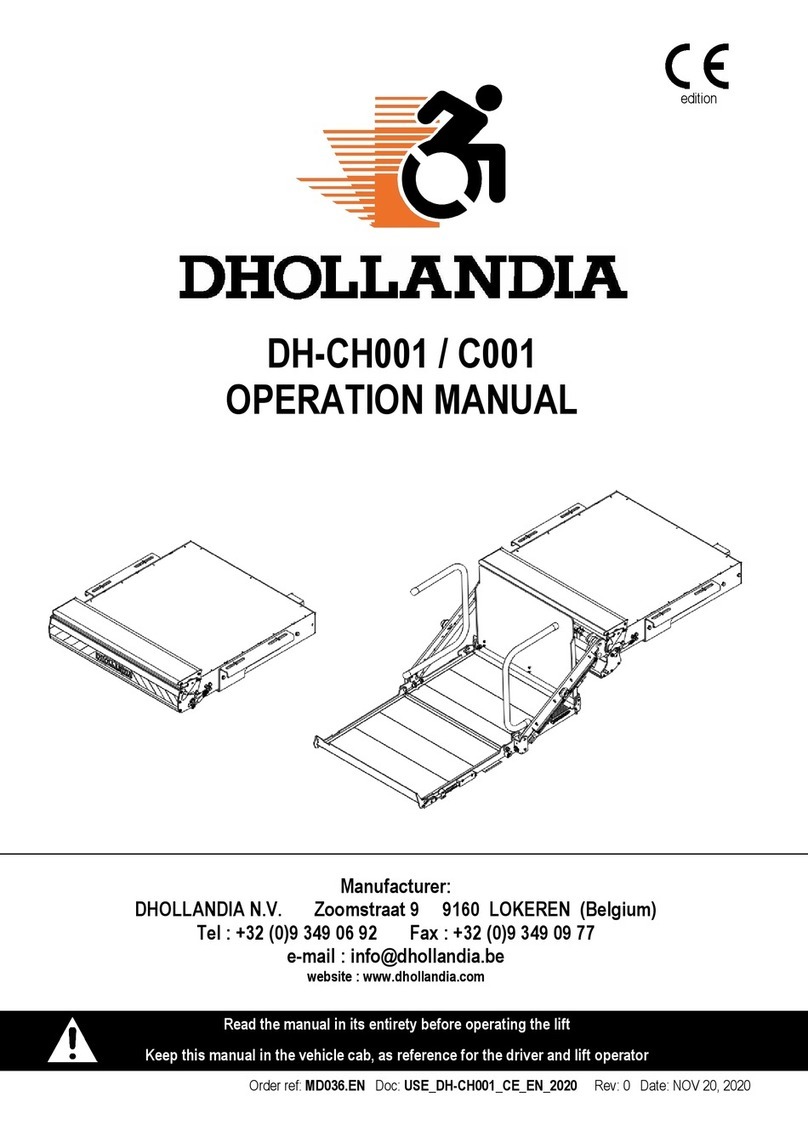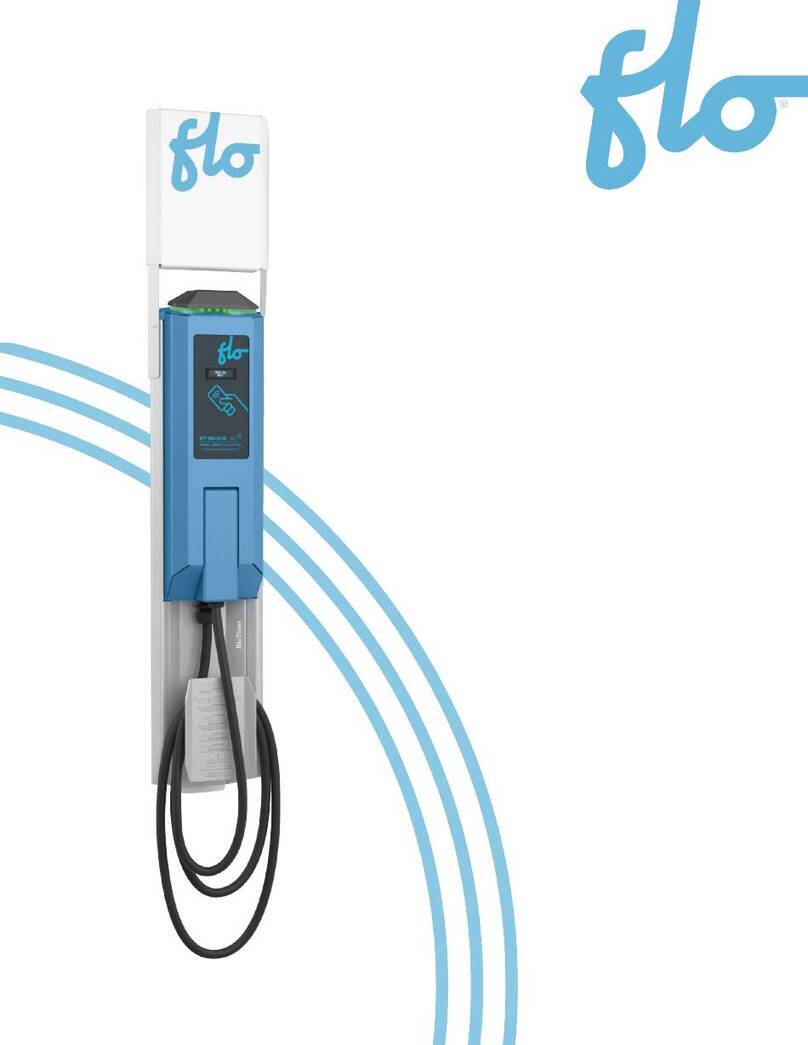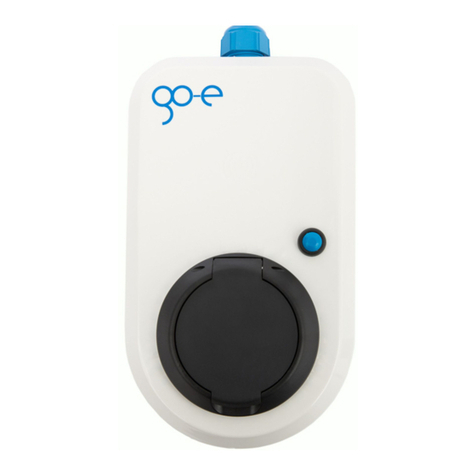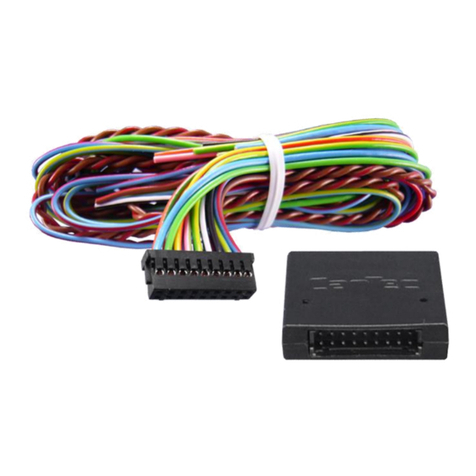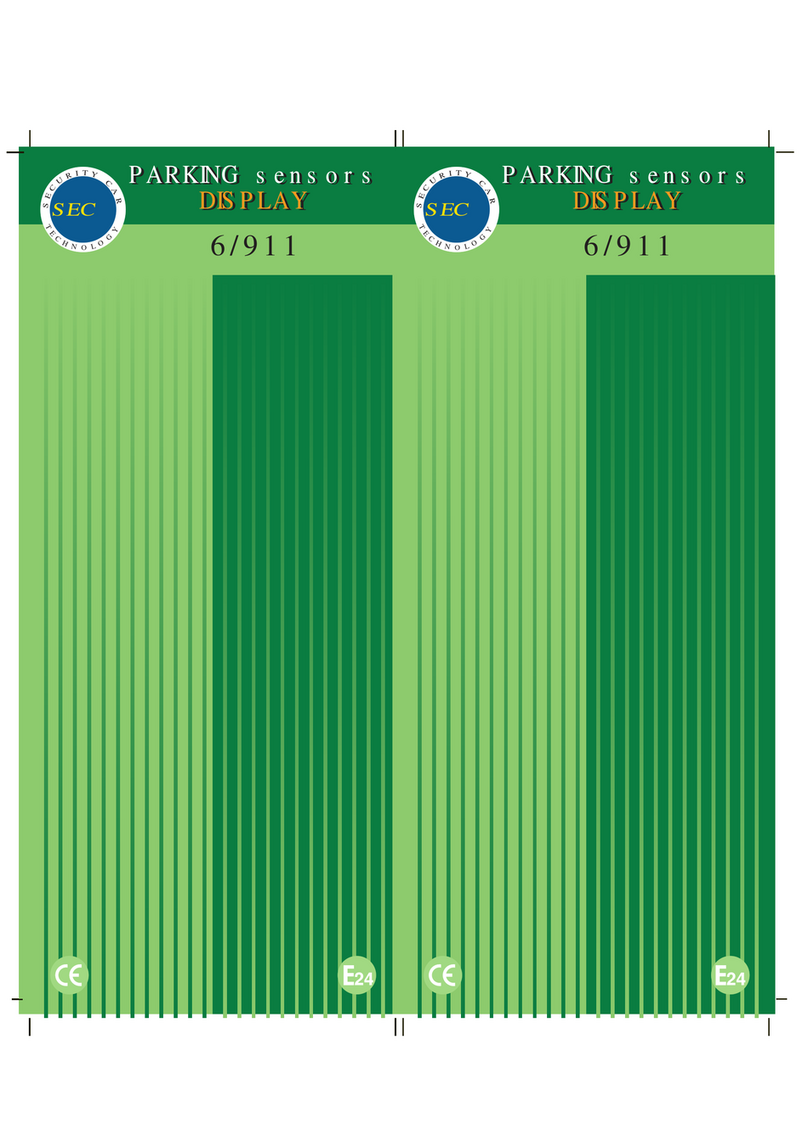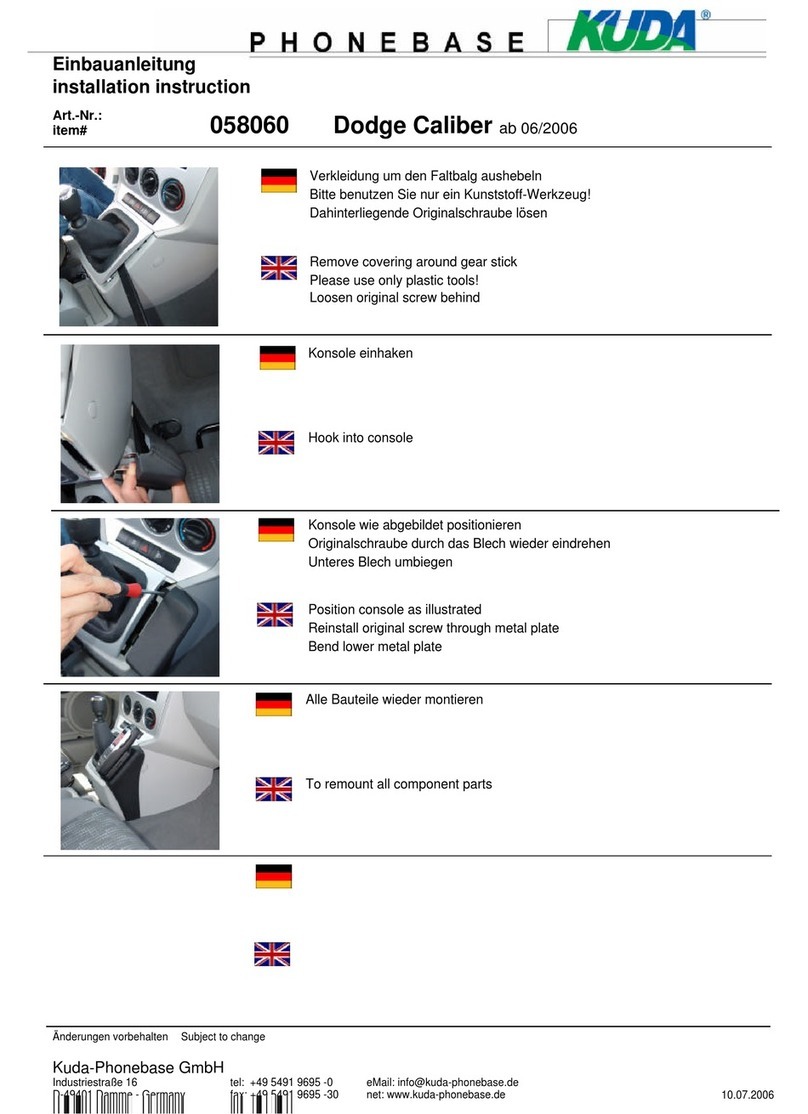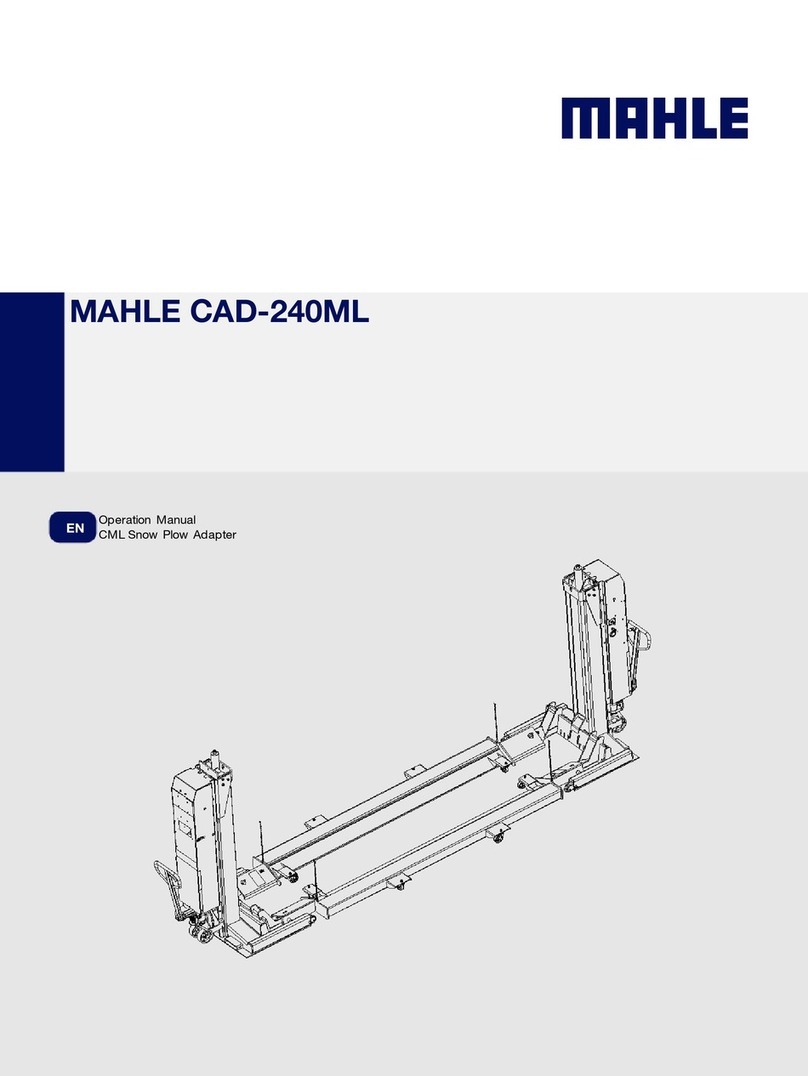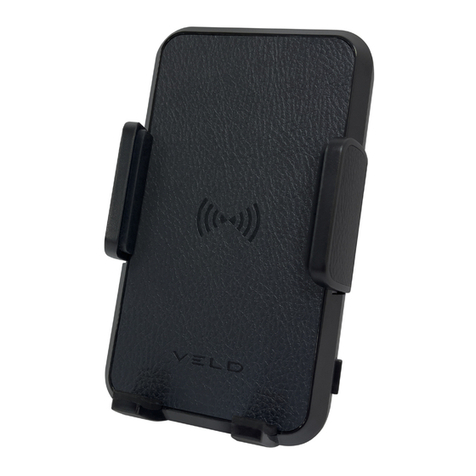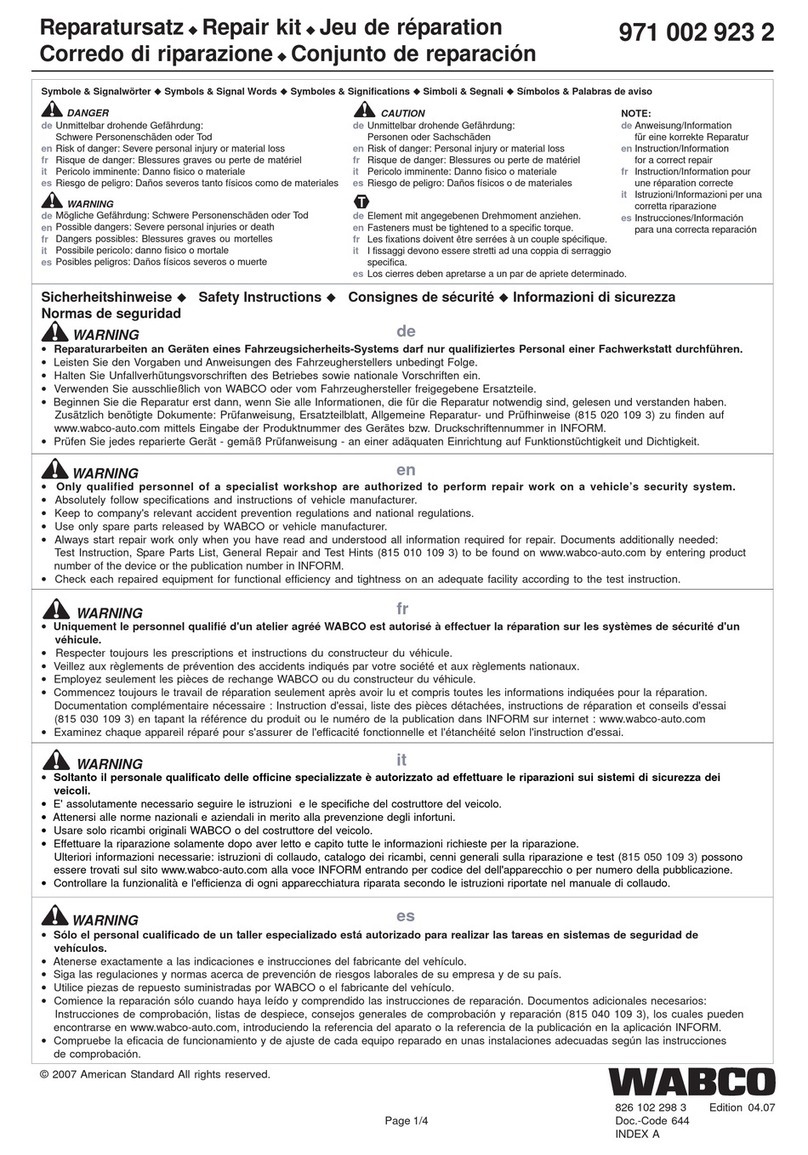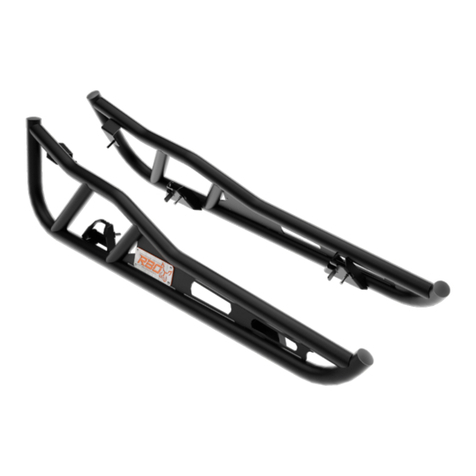Dhollandia DH-VOP K1 User manual

Doc: USE_VOP_US_EN_2020_rev0 Rev: 0Date: JANUARY 1, 2020
Manufacturer:
DHOLLANDIA US, L.L.C.
270 Southridge Parkway
Bessemer City North Carolina, 28016
website : www.dhollandia.com
DH-VOP K1 column liftgates
OPERATION MANUAL
Read the manual in its entirety before operating the liftgate
Keep this manual in the vehicle cab, as reference for the driver and liftgate operator

1
DHOLLANDIA
TABLE OF CONTENTS
1UNDERSTANDING SAFETY AND WARNING SIGNS........................................................................................................................ 2
2CONTACT INFORMATION AND DISCLAIMERS................................................................................................................................ 3
3GENERAL INTRODUCTION ............................................................................................................................................................... 4
4INTENDED USE .................................................................................................................................................................................. 4
5IDENTIFICATION ................................................................................................................................................................................ 5
6DESCRIPTION AND LIFTGATE TERMINOLOGY .............................................................................................................................. 5
7SAFETY INSTRUCTIONS FOR USING THE LIFTGATE.................................................................................................................... 8
7.1 DO NOT use liftgate without adequate safety and operator training........................................................................................... 8
7.2 General safety instructions.......................................................................................................................................................... 8
7.3 Danger zones, risk of crush and shear injury............................................................................................................................ 13
7.4 Safe operator position ............................................................................................................................................................... 15
7.5 Instructions for working at loading docks .................................................................................................................................. 17
7.6 Recommended daily pre-trip inspection.................................................................................................................................... 20
7.7 Importance of preventative maintenance .................................................................................................................................. 21
8LOAD CHARTS AND CORRECT LOADING PROCEDURES........................................................................................................... 22
9OPERATING INSTRUCTIONS - PRINCIPLES AND PROCEDURES............................................................................................... 26
9.1 Platform ride.............................................................................................................................................................................. 26
9.2 Main external controls on column liftgates with manual closure................................................................................................ 27
9.3 Main external control boxes on column lifts with hydraulic closure [ref OVH004 or OVH011] .................................................. 28
9.4 Most popular auxiliary controls.................................................................................................................................................. 31
9.5 Switching the main power ON / OFF......................................................................................................................................... 32
9.6 Operation of column lifts DH-VO with manual closure .............................................................................................................. 33
9.7 The use of cart stops................................................................................................................................................................. 37
10 DECALS............................................................................................................................................................................................. 40
10.1 Regular decals .......................................................................................................................................................................... 40
10.2 Use of the ‘WARNING. LIFTGATE OUT OF SERVICE. DO NOT ATTEMPT TO OPERATE’ sign .......................................... 43
11 MEANING OF SAFETY AND WARNING SIGNS .............................................................................................................................. 44
12 END NOTE ........................................................................................................................................................................................ 46

2
DHOLLANDIA
1UNDERSTANDING SAFETYAND WARNING SIGNS
Many safety signs and symbols used in this manual are based on international standards, others refer to specific situations or actions.
Consult section 11 for an overview of signs and symbols used in DHOLLANDIA manuals and their meanings.
Please take special notice of the following signs used in the manual. They indicate the likelihood and severity of a potential injury if a
person fails to follow the instructions presented on the safety sign.
WARNING
Failure to understand and follow the instructions in this manual can put the operator and any bystanders at great risk of serious
bodily injury and death.
Prior to operating the tail lift, make sure you understand the safety and warning signs used, and read them in conjunction with the
instructions in this manual.
If in doubt, DO NOT operate the tail lift. Contact your national DHOLLANDIA distributor. See page 3 for contact info.
NOTICE
DANGER: indicates an imminently hazardous situation which, if not avoided, will result in death
or serious injury. [white letters on red background]
WARNING: indicates a potentially hazardous situation which, if not avoided, could result in
death or serious injury. [black letters on orange background]
CAUTION: indicates a potentially hazardous situation which, if not avoided, could result in minor
or moderate injury. [black letters on yellow background]
NOTICE: is used to address practices not related to physical injury. [white letters on blue
background]
SAFETY INSTRUCTIONS: indicate general instructions relative to safe work practices,
reminders of proper safety procedures, or the location of safety equipment. [white letters on
green background]
SAFETY
INSTRUCTIONS
SAFETY ALERT SYMBOL: is used to alert the user to potential hazards. All safety messages
that accompany this sign shall be obeyed to avoid possible harm. [free-standing, or on back-
ground colours red, orange, yellow or black]

3
DHOLLANDIA
2CONTACT INFORMATION AND DISCLAIMERS
DHOLLANDIA liftgates are regularly being adapted to new vehicle and chassis developments and specialized customer requirements.
Therefore, DHOLLANDIA reserves the right to alter product specifications without prior notice; and potentially modifications or new
developments might not have been taken into account at the time of printing.
NOTICE
Please confirm you have reviewed the most up-to-date version of this manual prior to operation of the associated DHOLLANDIA liftgate.
See below for instructions to download the latest version of the manual.
Contact your national DHOLLANDIA distributor if you have any questions regarding the installation, operation, repair and maintenance of
DHOLLANDIA liftgates, to obtain replacement copies of manuals or decals, or to learn about available equipment options for DHOLLANDIA
liftgates.
Take notice of following important disclaimers:
DISCLAIMERS
DHOLLANDIA disclaims liability for any personal injury, death, or property damage that results from operating a liftgate that has
been modified from the original design, without explicit written approval from the manufacturer.
DHOLLANDIA disclaims liability for any personal injury, death, or property damage that results from use of aftermarket or non-
OEM replacement parts for service or repair of the liftgate.
DHOLLANDIA disclaims liability for any personal injury, death, or property damage that results from improper use of the liftgate.
DHOLLANDIA disclaims liability for any personal injury, death, or property damage that results from overloading or improperly
loading the platform, disregard of the maximum rated lift capacity and the applicable load charts.
There are no warranties, express or implied, including the warranty of merchantability or a warranty of fitness for a particular
purpose extending beyond that set forth in this manual.
The latest version of all manuals can also be downloaded from the DHOLLANDIA website
www.dhollandia.com → Downloads → User’s manuals → … select required manual
DHOLLANDIA US, LLC
United States - East
200 Hilton Street West
Easton PA 18042
Tel: 855-894-1188
Sales.USA@dhollandia.com
DHOLLANDIA CANADA, Inc.
Canada
2105 Boulevard des Entreprises
Terrebonne Quebec J6Y1W9
Tel: 888-750-5438
Sales.CANADA@dhollandia.com
DHOLLANDIA MEXICO, Inc.
Mexico
Fraccionamiento Industrial
Dinamo del Norte,
Calle Tierra 103-105
C.P. 65500, Salinas Victoria,
Monterrey- Nuevo Leon
Tel: +52 81 13340968
Sales.MEXICO@dhollandia.com
DHOLLANDIA US, LLC
United States - West
12968 Santa Ana Avenue
Fontana CA 92337
Tel: 855-856-8225
Sales.USA@dhollandia.com

4
DHOLLANDIA
3GENERAL INTRODUCTION
This OPERATION MANUAL explains how the DHOLLANDIA liftgate is manufactured, what safety devices are incorporated in its
design; and how to use the liftgate in a correct manner, that preserves the integrity of the machine over the intended lifetime and helps
maximize the safety of the operator and any bystanders.
The MAINTENANCE AND REPAIR MANUAL (separate) explains how to maintain and service the liftgate in the appropriate manner,
maximizing the safety of the operator and any bystanders, and ensuring the reliability of the liftgate over the intended lifetime.
The manuals must be kept with the liftgate at all times, as a reference book for the operators and technical service
This OPERATION MANUAL only covers column lifts that stop at, and reach no higher than the cylinder beam mounted at the (lowest)
vehicle floor (executions K1 or K1 + K2). This manual is NOT suitable for column lifts that extend above the vehicle floor (execution
K9 or K9 + K2). If your lift travels above the cylinder beam mounted at the (lowest) vehicle floor, contact DHOLLANDIA to obtain the
relevant operation manual. See contact info on page 3.
4INTENDED USE
DHOLLANDIA liftgates are designed to be fitted to commercial vehicles (commercial trucks, trailers and semi-trailers), and shall be used
exclusively to load and unload the goods transported on the vehicle it is fitted to, within the limits of the load chart, in compliance with the
operator instructions and safety instructions described in this manual.
WARNING
Improper use of the liftgate will put the operator and other parties at great risk of serious bodily injury and death. Therefore, the use
of the liftgate is restricted to skilled operators only; who have been properly trained, and who know and understand the full contents
of this manual.
Unauthorized modifications to the liftgate can put the operator and other parties at great risk of serious bodily injury and death.
Therefore, it is strictly forbidden to modify the liftgate and its safety devices in any way.
Use of aftermarket or non-OEM replacement parts to repair or maintain the liftgate is strictly prohibited and may result in serious
bodily injury or death to the operator or any bystanders.
WARNING
Improper use of the liftgate will put the operator and bystanders at great risk of serious bodily injury and death. Therefore, it is
strictly forbidden to use the liftgate in a different way, or for different purposes than described in the operation manual.
The liftgate must NEVER be used as an elevated work platform, to push loads, or to carry people.
The liftgate must NEVER be used as a wheelchair lift.

5
DHOLLANDIA
5IDENTIFICATION
6DESCRIPTION AND LIFTGATE TERMINOLOGY
DHOLLANDIA liftgates are developed and manufactured using state-of-the-art technology, high quality materials and components and
highly skilled workmanship.
The DH-VOP.K1, is a column liftgate, designed specifically for use on smaller vehicles, and has a lift capacity ranging from 1,100 to
1,650lbs.
In its travel position, the platform of the column liftgate is stowed vertically behind the vehicle body. Before use, the platform is lowered
approx. 7”, then tilted open 90 degrees from the vertical travel position, to a horizontal work position.
See table below for more details:
Type
Lift capacity
Manual closure
Hydraulic closure 0-
90°
OVH004
Hydraulic closure with
adjustable platform
pitch
OVH011
DH-VOP.K1
1,100 - 1,650 lbs
standard
not available
not available
Every DHOLLANDIA liftgate is identified by and labelled with
a unique 8-digit serial number (with or without a space
between the first and last 4 digits). Use this number for any
inquiry on a particular liftgate, or when ordering replacement
parts.
In addition to the liftgate type and serial number, the various
serial number labels provide additional information, such as:
the maximum rated lift capacity and load chart, the date of
manufacture, etc...
These labels are usually affixed to various liftgate
components, and can be found in following locations (the
yellow arrows point to the serial numbers):
Affixed to the side of the vehicle body, or on the platform
On the lift frame
On the platform
On the main external control
box

6
DHOLLANDIA
DH-VOP.K1 ● MANUAL CLOSURE ● LIFTGATE TERMINOLOGY
See figure below for parts corresponding to numbers in this table
#
Description
1
Lift columns: set of 2 columns mounted in a fixed position against the vehicle body. These form the rails within which the lift
runners carrying the platform travel up and down.
2
Cylinder beam: horizontal beam mounted at the vehicle floor. This beam contains the lift cylinder; the drive system consisting
of chains and pulleys; and often also the hydraulic pump unit.
3
Lift cylinder: hydraulic cylinder used to LOWER / LIFT the lift runners, the platform and its load.
4
Hydraulic pump unit: contains the electric motor driving the hydraulic pump, the oil tank, and the control valves. The unit can
be premounted inside the cylinder beam (if technical parameters allow so), or is mounted separately on the vehicle chassis.
5
Platform: carries the load during lifting and lowering. Manufactured from steel or light-weight aluminium and with a non-slip
working surface. In standard execution, the platform is equipped with a fixed leading edge. Optional cart-stops in the platform
surface, or a retention ramp at the outboard platform edge, are available as an option.
6
Torsion bar(s): powerful spring device hidden inside the platform, assisting with the manual OPEN / CLOSE of the platform (in
case of manual closure)
7
Lift runners: set of 2 slides carrying the platform, travelling up and down in the lift columns. They are lifted and lowered by the
lift cylinder and the drive mechanism (chains and pulleys).
8
Platform lock: pivoting lock on the near-side lift runner with dual function:
1. Platform in vertical position: the hook holds the platform closed against the lift runners. Release the platform lock to open the
platform.
2. Platform in horizontal position: the lock blocks the platform in work position, and prevents the torsion bar(s) from tilting up the
platform. Release the platform lock to close the platform.
9
External Toggle Switch: mounted in a fixed position at the side of the lift column. It contains the electrical switches to LOWER
/ LIFT the platform.
10
Center point of maximum load: point up to which the maximum rated capacity of the liftgate is valid. Beyond that point, the
maximum safe working load diminishes according to the applicable load charts found at Section 8 of this manual.

7
DHOLLANDIA
DH-VOP.K1 ● MANUAL CLOSURE ● LIFTGATE TERMINOLOGY
❾
❽
❼
❻
❺
❹
❸
❷
❶
❿

8
DHOLLANDIA
7SAFETY INSTRUCTIONS FOR USING THE LIFTGATE
7.1 DO NOT USE LIFTGATE WITHOUT ADEQUATE SAFETY AND OPERATOR TRAINING
DHOLLANDIA liftgates shall be exclusively used to load and unload the goods transported on the carrying vehicle, within the limits of
the applicable load chart, in compliance with the operator instructions and safety instructions in this manual.
The operator should follow all other policies and procedures applicable to the job situation including health and safety regulations,
road and traffic regulations, as well as company procedures. The operator should not use the liftgate if he / she cannot use it in
accordance with all applicable regulations and instructions.
The operator must be at least 18 years of age.
7.2 GENERAL SAFETY INSTRUCTIONS
WARNING
Improper use of the liftgate will put the operator and other parties at great risk of serious bodily injury and death.
To reduce the risk of serious bodily injury to the operator and any bystanders, the use of the liftgate is restricted to skilled operators,
who have been properly trained, and who know and understand the full contents of this manual.
To reduce the risk of serious bodily injury or death, THE OPERATOR MUST COMPLY WITH ALL SAFETY INSTRUCTIONS AND
WARNING LABELS IN THIS SECTION AND THE ENTIRE MANUAL before and while operating the liftgate.
WARNING
To avoid serious bodily injury or death, the operator must use appropriate work clothes. NEVER wear loose-fitting clothes that
may be trapped in the moving parts of the liftgate. ALWAYS wear professional safety-toe shoes, protective gloves, and eye
protection. Use of a hardhat is recommended.
Slipping (and falling) can result in serious bodily injury and death. To prevent injury by slipping:
oALWAYS wear professional safety-toe shoes with a good non-slip sole.
oDO NOT use the liftgate if it is covered with snow, mud, dirt, debris, liquids or other substances.
oDO NOT run on the platform.
Tripping (and falling) can result in serious bodily injury and death. To prevent injury by tripping:
oDO NOT use liftgate platform as a step. NEVER leave the liftgate unattended in partially deployed position.
oPay attention to protruding items on the platform surface at all times (ex. platform lights, cart-stops and their
levers, foreign objects, etc…).
oDO NOT run on the platform.
Falling from the platform can result in serious bodily injury and death. To prevent injury by falling:
oMake sure your footing is solid, and you maintain 3 points of contact. See 7.4.
oUse safety rails where available. See 7.4.
oNEVER move the vehicle while a person is standing on the platform, or inside the vehicle body.
oNEVER use the platform as an elevated working platform.

9
DHOLLANDIA
WARNING
Prior to operating the liftgate, the vehicle must be safely parked on level and solid ground, have the parking brake applied, and the
engine switched off. Lock open the rear doors and secure all other moving parts of the vehicle body. Failure to abide by these
instructions can result in serious bodily injury or death to the operator or bystanders.
Ensure that the vehicle cannot tip-over when putting heavy weight on the platform. If the vehicle or the liftgate are equipped with
mechanical or hydraulic stabilizing legs, deploy these before opening the platform. Ensure that the stabilizing legs are positioned
on solid, even ground. In case of soft terrain (sand, gravel), solid support blocks must be used under the stabilizing legs. Failure
to abide by these instructions can result in serious bodily injury or death to the operator or bystanders.
To reduce the risk of serious bodily injury or death which may
result from other vehicles when parked, ALWAYS make sure a
safety distance of 16 ft. or 5 m. is kept between the back of the
truck and the following vehicle.
To reduce the risk of serious bodily injury or death, ALWAYS
make sure the platform is clearly visible to other persons from
all approach directions. DHOLLANDIA recommends the use of
4 warning cones, placed around the work area of the platform.
[See notice below].
To reduce the risk of serious bodily injury or death, make sure
the working zone is sufficiently lighted.

10
DHOLLANDIA
When loading or unloading to a back down loading dock. Make
sure to not hit the wall with the body / liftgate. Failure to abide
by these instructions can result in material damage, serious
bodily injury or death to the operator or bystanders.
NOTICE
DHOLLANDIA offers optional platform mounted flashing lights and flags to make the platform more visible to other people. Please
visit www.dhollandia.com or contact the national DHOLLANDIA distributor for more information. See page 3 for contact info.
WARNING
Prior to releasing the mechanical platform lock (if so equipped) and using the liftgate, check if the liftgate can be used safely. Take
precautions to ensure your own safety, and the safety of bystanders or other parties in traffic. Clear the working area of any objects
that could potentially impede movement of the liftgate. Failure to abide by these instructions can result in serious bodily injury or
death to the operator or bystanders.
Inspect the liftgate prior to each use. If any unsafe condition exists or unusual noises
or movements are noticed, DO NOT use the liftgate and contact an authorized
DHOLLANDIA service agent for repair. Please see ‘pre-trip inspection’ procedures
under 7.6.
Read and comply with all warning decals, pictograms and instructions affixed to the
liftgate. Failure to abide by warnings and instructions may result in serious bodily injury
or death.
The liftgate must not be used if the operator is intoxicated, impaired or distracted in any way. NEVER use a phone or mobile device
when operating the liftgate.
The liftgate shall be used by means of original control units only. Operating the liftgate with unauthorized control units will increase
risk of serious bodily injury or death to the operator or any bystanders.
Limit the operation of the liftgate to one single operator. Operation of the liftgate by more than one operator at a time may cause
confusion and increase the risk of serious bodily injury or death.

11
DHOLLANDIA
To prevent people from being hit by the platform, by objects falling off the platform or being caught in pinch points or being pinched
by the moving parts of the liftgate:
→Keep visual control over the entire working area of the liftgate and its platform at all times, including the area
DIRECTLY BEHIND and UNDER the platform.
→DO NOT allow any other person, to stand in the proximity of the liftgate and its platform. ENSURE AT ALL TIMES
THAT NOBODY STANDS UNDER OR WITHIN REACH OF THE MOVING PLATFORM.
When unloading from the vehicle body to the platform,
ALWAYS push the load out, to prevent the load from hitting you.
NEVER pull the load from the vehicle onto the platform. Pulling
the load from the vehicle can result in a fall from the platform
causing serious injury or death.
If pushed out too far, the load can fall off the platform, and cause
serious bodily injury or death to other people. Deploy the cart-
stops before pushing out the load. If not available, push the load
slowly while checking the outboard platform edges.
The load must ALWAYS be secured when raising or lowering
on the liftgate, to prevent it from shifting position and rolling off
the platform edges. Failure to properly secure the load will
increase the risk of serious bodily injury or death to the operator
or any bystanders.
When using a pallet jack, lower and rest the pallet or load upon
the platform surface before operating the liftgate.
For loads on wheels, engage wheel brakes of carts, trolleys and
machinery (if available) before operating the liftgate.
For loads that could slip, the use of original DHOLLANDIA cart-stops or an appropriate alternative securement device (ex. ratchet
straps) is required. The load must not be able to move during movement of the platform. See 9.9 for correct use of original
DHOLLANDIA cart stops.
NEVER leave the liftgate unattended in open position. Before leaving the vehicle unattended, close the doors of the vehicle, stow
the platform in its travel position and switch OFF the main battery disconnect switch in the external control box (if so equipped), or
the cab switch. Leaving the liftgate in open position unattended can result in serious bodily injury or death to unaware bystanders.
See 9.5 for instructions on properly stowing platform into its travel position.
NEVER move the vehicle with the liftgate in the open position. ALWAYS close and secure the doors of the vehicle, stow the liftgate
in its travel position and switch OFF the main battery disconnect switch in the external control box (if so equipped), or the cab
switch, before moving the vehicle. If so equipped, close the mechanical platform lock after stowing the platform in its travel position.
Failure to properly stow the liftgate in its travel position prior to moving the vehicle may result in serious bodily injury or death.
Use of the liftgate near vehicular traffic may result in serious bodily injury or death from being struck by another vehicle. When
operating the liftgate on or near a street or parking lot, be sure to stay clear of vehicular traffic. ALWAYS be sure to clearly identify
to other drivers that the liftgate is in use. DHOLLANDIA recommends use of warning cones to clearly identify to drivers that the
liftgate is being operated. When the liftgate is operated near vehicular traffic, wear working clothes in high-visibility colors and a
retro-reflective safety vest.

12
DHOLLANDIA
DO NOT raise the liftgate with the rear doors partially open. Doing so may damage the doors or the liftgate platform and may also
result in serious bodily injury or death to the operator or any bystanders.
Above all, USE GOOD COMMON SENSE when operating the liftgate. DO NOT operate the liftgate until the contents of this manual
have been read and fully understood. Improper use of the liftgate increases the risk of serious bodily injury or death to the operator
and any bystanders.

13
DHOLLANDIA
7.3 DANGER ZONES, RISK OF CRUSH AND SHEAR INJURY
There are 4 main danger zones on and around the platform, that can be hazardous to the operator and any other persons nearby:
WARNING
Impact by the platform or the moving parts of the liftgate will result in serious bodily injury or death. To
prevent people from being hit by the platform, by objects falling off the platform or being caught in pinch
points or being pinched by the moving parts of the liftgate:
Keep visual control over the entire working area of the liftgate at all times, including the area directly
behind and under the platform.
DO NOT allow any other person to stand near the liftgate and its platform. Ensure at all times that
nobody stands under, or within reach of the moving platform and its load.
Correct operator position
Danger zone
1. ALWAYS stay clear of the
range of motion of the
platform
❶
❶
2. Beware of crushing zone
between lowering platform and
ground
❸
❷
❸
3. Beware of the crushing zone between
rising platform and vehicle floor

14
DHOLLANDIA
4 [continued]. In case of platforms equipped with manual closure and automatically folding safety rails (sides only), or gas-bottle execution
(sides + rear), make sure you use the grab handle on the safety rail to open and close the platform.
WARNING
The operator or other persons approaching too close to these danger zones risk serious bodily injury or death
by pinching, crushing or shearing of limbs, upper body or head. To prevent these hazards:
→ALWAYS stand clear of the range of motion of the platform and moving parts of the liftgate;
→Keep hands, feet and upper body clear of pinch points and moving parts of the liftgate;
→DO NOT allow any other person to stand near the liftgate and its platform.
4. Beware of the crushing zone between
closing platform and rear frame of vehicle
body
❹
❹
4 [continued]. Most column lifts are equipped with a
device that shut closes the platform tight against the
lift columns, after it was tilted in the vertical position
and while it is lifted in its travel position.
Therefore, the operator MUST stand on the side of
the platform and keep head, limbs and upper body
clear of hazardous space between the platform and
the lift columns, while stowing the platform in its
travel position.

15
DHOLLANDIA
7.4 SAFE OPERATOR POSITION
Main external control box: the zone beside the vehicle body, just in
front of the toggle switch control or side-mounted external control box, is
the safest position from where the operator can LOWER and unfold the
platform into the work position; LIFT and LOWER the platform to load
and unload; or fold and LIFT the platform back in its travel position.
Auxiliary controls: the operator may also LOWER and LIFT the platform
through use of the auxiliary controls. The operator must use extreme
caution when lowering or lifting the platform with the auxiliary controls
and must ensure it is done from a safe position. Use of auxiliary controls
from an improper position greatly increases the operator's risk of
crushing or shearing of toes, limbs, head, and upper body as well as
death.
The operator may also LOWER and LIFT the platform through the use of
the platform mounted foot controls (optional) which restrict both
operator's feet to a predetermined position on the platform. The operator
must use extreme caution when using platform mounted foot controls
to avoid falling from the platform. ALWAYS maintain 3 points of contact
(see next page).
Handheld auxiliary controls with a spiral cable should only be used under the following conditions:
On the platform, from a safe operator
position of minimum 16”x16” square,
clearly and permanently marked at
minimum 10” distance from the hazard
zone between the platform and the rear
of the vehicle floor. Maintain 3 points of
contact (see next page).
Inside the vehicle body, from a safe
operator position of minimum 16”x16”
square, clearly and permanently marked
at minimum 10” distance from the hazard
zone between the platform and the rear
of the vehicle floor.
On the ground, from a safe operator
position at a minimum of 20” away from
the side edge of the platform.
20”
16”
10”
16”
10”

16
DHOLLANDIA
A fixed internal control should only be used inside the vehicle body from a
safe operator position that is a minimum 16"x16" square, clearly and
permanently marked at a minimum of 10" from the hazard zone between
the platform and the rear of the vehicle floor. A fixed internal control should
NEVER be used from a position on the platform.
The marked operator positions on the platform must be kept clear at all
times. It is prohibited to place a load on these dedicated areas.
In case of a main external control box with 2-hand operation, the power to
any of the auxiliary controls must be connected to and dependent upon the
safety switch in the main external control box. Activation of the auxiliary
controls must deactivate the functions on the external control box.
It is prohibited to bypass or modify any of the safety features of the liftgate. If connection of the power to the external control box does
not deactivate external controls, stop using the liftgate, attach the 'WARNING. LIFTGATE OUT OF SERVICE. DO NOT ATTEMPT
TO OPERATE' sign provided with the liftgate, and contact an authorized DHOLLANDIA agent.
WARNING
If not standing solidly, an operator on
the platform risks serious injury or
death by falling off.
While riding on the platform, ALWAYS
make sure your footing is solid, and
ALWAYS maintain 3 points of contact,
as shown in the picture to the right.
When reaching out your hand for a 3rd point
of contact, ALWAYS stay clear of the open
lift columns and the moving lift runner,
chains, and sprockets.
Note: these 3 points of contact usually include the 2 feet
positioned solidly on the platform, and a handgrip mounted to
the rear frame of the vehicle body.
WARNING
When standing in front or behind the load, the operator risks being pushed off the platform, or being crushed between the moving
load and the rear frame of the vehicle body, resulting in serious bodily injury or death.
To prevent this hazard, ALWAYS stand on the side of the load, NEVER in front or behind.
10”
16”
32”

17
DHOLLANDIA
7.5 INSTRUCTIONS FOR WORKING AT LOADING DOCKS
There are 3 main ways of handling a column lift at the loading docks:
When the intention is to dock with the platform lowered below the vehicle floor level, DO NOT lower the platform until the vehicle is standing
on flat even ground. ALWAYS revers slowly, and make sure you maintain sufficient ground clearance between the lowest part of the liftgate
and the ground. Take into account variations in the suspension and vehicle height.
NOTICE
When reversing a vehicle with column lift into a loading dock, ALWAYS make sure there is sufficient ground clearance between
the lowest part of the liftgate and the ground.
ALWAYS reverse slowly, and avoid hard dock impact on the liftgate.
Reversing with insufficient ground clearance, or with too hard dock impact may result in severe damage to the liftgate.
WARNING
Improper use of the liftgate may result in damage, premature wear or failure of the liftgate, and will increase the risk of serious
injury or death to the operator and other persons nearby.
In order to maximize the durability, ensure long-term reliability of the liftgate, and protect operators and bystanders from serious
bodily injury or death, the operator must comply with the loading instructions and safe working procedures below.
1. Platform lowered below the vehicle
floor level. All cargo is loaded / unloaded
over a dock-plate that links the dock and
the vehicle floor.
2. Platform is used as a loading
platform; or as a bridge plate (in case of
optional tilt cylinders)
3. Platform is hidden in a pocket or
briefcase under the loading dock. All
cargo is loaded / unloaded over a dock-
plate that links the dock and the vehicle
floor.
Min. 5”

18
DHOLLANDIA
When the intention is to use the platform as a loading platform or bridge plate, following instructions apply:
The liftgate can only be used as a
loading platform if the dock is lower than
the vehicle floor.
The liftgate can be used as a bridge
plate, if it is equipped with the optional
tilt cylinders with adjustable platform
orientation.
It is forbidden to drive forklifts or heavy
electric pallet jacks over the platform.
The total weight of the load and the
lifting device must not exceed the
maximum rated capacity of the liftgate.
Beware not to overload!
OVERLOAD
While loading or unloading, the loading
floor of the vehicle might lower or rise
relative to the loading dock. Use the
electrical controls to adjust the platform
position flush with the loading dock
surface.
Min. 10”
A minimum section of 10” of the
outboard platform edge must cover the
loading dock.
NEVER use a foldable platform as a
bridge plate between the vehicle floor
and a loading dock. Keep the platform
securely stowed in its travel position to
avoid damage
NEVER use a dock plate on top of a
floating platform as a bridge between the
loading dock and vehicle floor.

19
DHOLLANDIA
When the intention is to stow the platform in a pocket or brief case
under the loading dock, observe following points before reversing into the
dock:
Make sure the pocket is deep enough for the depth of the platform.
Make sure there is sufficient clearance above and below the platform,
taking into account all possible variations in vehicle suspension and
vehicle floor height.
Make sure the platform does not touch the ceiling, ground or end wall
of the pocket.
Whenever cargo is loaded or offloaded with forklifts, electric pallet jacks, and the total weight of the load plus handling equipment exceeds
the maximum rated capacity of the liftgate, ALWAYS use a dock plate from the loading dock to the vehicle floor, and safely stow the lift
below the vehicle floor level, or in the pocket or brief case under the loading dock.
Min. 8”
Min. 8”
Min. 8”
OVERLOAD
Table of contents
Other Dhollandia Automobile Accessories manuals
